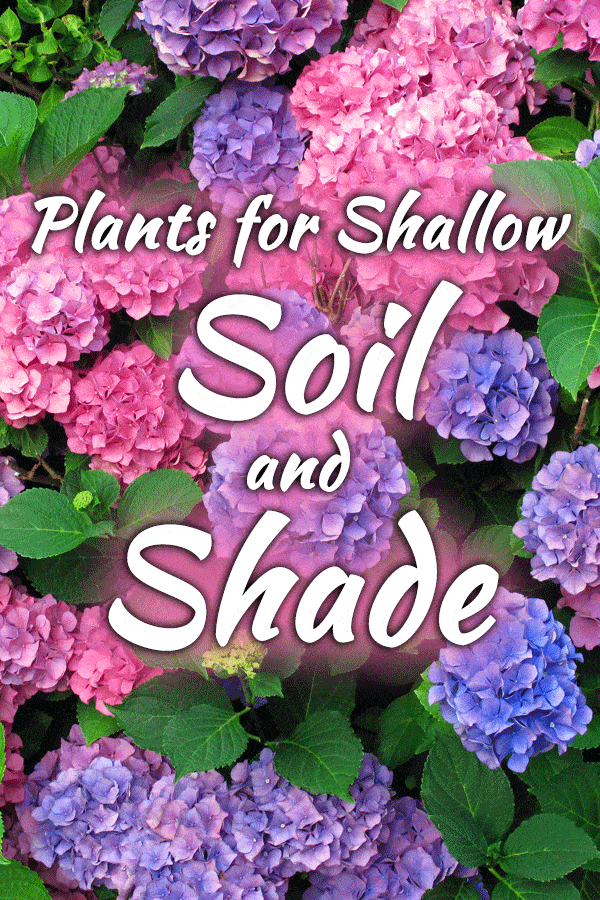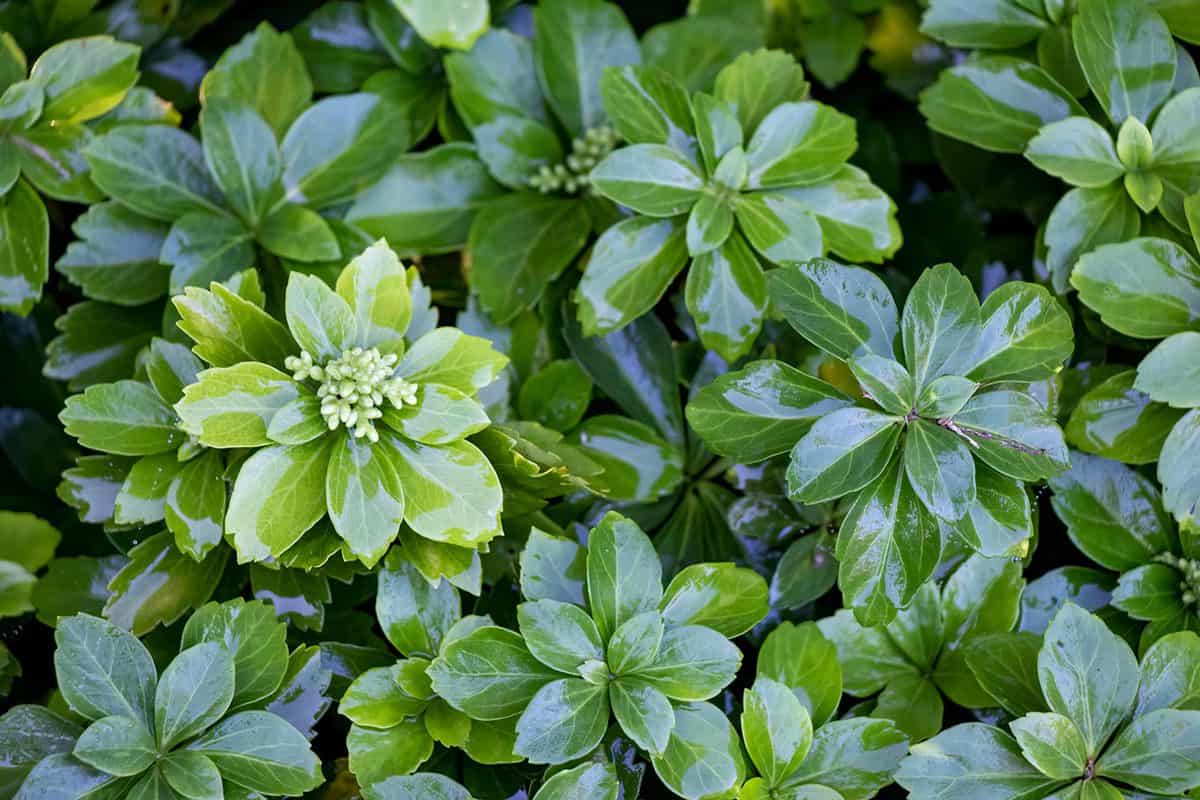 Trying to find beautiful plants that will thrive in shady places that have shallow soil like under trees, or along walkways can be challenging. We have done the research and have found 14 wonderful plants to help you get started.
Trying to find beautiful plants that will thrive in shady places that have shallow soil like under trees, or along walkways can be challenging. We have done the research and have found 14 wonderful plants to help you get started.
1. Periwinkle
Over 30 different varieties of this plant exist, showing off different types of foliage and bloom colors. It grows in the USDA hardiness zones 9-11, meaning it performs best in warmer climates found in the tropics or the South. It grows as a ground cover plant, reaching a height of 2 to 3 feet and a width of the same measurements. Containers and hanging baskets can help accentuate their beautiful, vibrant trailing blooms.
Its dark glossy green leaves are 2-3 inches in length and are ovate. The Periwinkle continuously blooms from early spring until the fall. Each bloom is over 1 inch in width and can come in shades of red, white, pink, and purple.
Since the Periwinkle is deer resistant, it can help protect the other plants in your garden. It can also tolerate extended periods of drought and heat.
Click here to see more on Amazon.
Click here to see more on Amazon.
2. Pachysandra

Five different species of this evergreen perennial make up this genus. This plant, also known as Spurge, performs well in the shade and moist soil and is very hardy. During the spring months and early summer, it shows off small white flowers. Glossy green evergreen-toothed foliage fills out large spaces nicely.
Growing to a height of about 8 to 12 inches, it serves as a great ground cover and weed-blocking plant. It looks exceptional underneath the shade of large trees, adding a vibrant green color and dimension to an area that can be hard to inhabit.
Since they have succulent stems, take care not to walk around in your Pachysandra as it can be easily damaged.
Click here to see more on Amazon.
3. Hostas
Low maintenance and easy to grow, Hostas are a shade-loving favorite among gardeners. Hostas perform well in zones 3 through 9 and do best when planted in well-draining moist soil. They come in sizes from miniature to giant, having 6-inch clump heights up to greater than 2 feet.
Large, beautiful green leaves are shown off on each plant. The varieties are endless, each one possessing a different leaf size, shape, or color. Though they don't have flowers of their own, their interesting leaves complement the blooms and shapes of other plants.
If they're planted in full sun exposure, they'll quickly wither and become sunburned from the intense heat. Unfortunately, deer like to snack on these plants, so you should plant them near deer-resistant plants or in hard-to-access areas to help fend them off.
Click here to see more on Amazon.
Click here to see more on Amazon.
4. Rhododendrons

This flowering evergreen plant exhibits large clusters of white, yellow, pink, red, or purple fragrant blooms that last from early spring through the summer. The flowers could be tube-, trumpet-, or bell-shaped while their foliage is paddle or elliptical-shaped. Over time, they can grow into large bushes full of attractive blooms and foliage.
With over 1,000 varieties of this plant, it's no surprise that you can find them in a diverse range of sizes. The smallest grow up to 40 inches, while the largest can grow up to a height of 100 feet.
Rich well-draining soil full of organic material is essential for the survival of Rhododendrons. They can live in arctic regions and tropical regions, all depending on growing conditions such as having adequate water, protection from harsh winds, living in acidic soil, and protection from temperature extremes.
Click here to see more on Amazon.
5. Hydrangeas
Growing in USDA hardiness zones 3 through 9, Hydrangeas have a diverse area in which they thrive. These shrubs can be either evergreen or deciduous, depending on which of the over 80 varieties that it is. Hydrangeas can grow between 3 feet to 15 feet in height. Some varieties even have a climbing habit of growth.
Their large flower clusters bloom from early spring through the summer and are brilliant shades of white, pink, red, purple, or blue. Their main flower clusters bloom from the tips of the shoots that formed during the previous season.
While they like the warmth of the morning sun, they dislike the harsh heat during the day and evening. Keep Hydrangeas adequately watered. Prune them every year in order to have them bloom in the following year.
Click here to see more on Amazon.
Click here to see more on Amazon.
6. English Ivy
This evergreen ivy is an exceptional climber and can practically grow up anything. Their vines can grow over 50 feet in length, each leaf measuring a few inches in length. In the first couple of years, growth is slow, but it significantly picks up pace in the third year and beyond. If there is no vertical space to climb, it can also serve as ground cover.
They perform best in moist soil, but once it has been established for a few years, they can tolerate periods of drought. It will grow in USDA plant hardiness zones 5 through 11.
Click here to see more on Amazon.
7. Aspidistra

This evergreen perennial, commonly known as the "Cast Iron Plant," features large beautiful ornamental green leaves. The elongated dark green leaves are ribbed with light green or creamy white stripes. Uniquely, its lilac or brownish bell-shaped flower blooms grow at the base of the plant.
Once it has been established, it can tolerate periods of drought, neglect, and other harsh circumstances. Over time, it can grow up to 2 feet in height, but only a few new leaves grow each year, making it a slow grower.
Plant it in near shade or shaded areas because too much sunlight is harsh on the growth of the plant. It doesn't require much water; let the first few inches of soil dry out before watering it again. It makes for a stunning, low-maintenance houseplant.
Click here to see more on Amazon.
8. Liriope
Also known as "Monkey Grass," this herbaceous low-growing herbaceous ground cover plant displays beautiful spike-shaped blooms. The flowers can be lavender or white and will bloom from August through September. Its long slender leaves are dark green, complementing the colorful blooms.
It reaches between 9 and 18 inches in height and spreads to a width between 12 to 24 inches. Liriope thrives best in the hardiness zones 4 through 10, giving it a wide geographic survivability range. A need for this plant is well-draining soil, but it can grow in sandy or clay soil and live in full sun or partial shade.
Rabbit and Deer tend to avoid this plant while butterflies and hummingbirds make regular appearances on it.
Click here to see more on Amazon.
Click here to see more on Amazon.
9. Ferns
With over 10,000 different species, it's no surprise that there are diverse and numerous characteristics of this plant. They are a type of nonflowering vascular plant that reproduces by way of spores. Warm and moist climates are best for this plant. Their leaves are complex and display a range of vibrant green colors.
Most of their root systems are delicate and will need rich nutrients and well-draining soil to avoid waterlogged root systems. Protect the plant from direct sunlight since it can cause yellowing or loss of the leaves.
Click here to see more on Amazon.
Click here to see more on Amazon.
10. Bugleweed
Fast-growing and hardy, this plant works well for filling in large shaded spaces where it's difficult to grow other plants. As a ground cover plant, it creates a dense mat low to the ground, only ever reaching about 8 inches in height. Its leaves are small, dark, and shiny. Its purple spike-shaped flowers are tiny and bloom from May to June.
Slightly acidic, well-draining soil is best for the Bugleweed as well as keeping it in medium moisture. It can grow in hardiness zones 3 through 10, making it able to withstand a range of temperatures.
Some gardeners don't like its rapid spread of growth, so monitor where it's planted and where it could spread. Deer generally avoid this plant.
Click here to see more on Amazon.
11. Lily of the Valley
Extremely aromatic white bell-shaped flowers decorate this shade-loving plant. Its sweet blooms appear from early spring through early summer. It is a ground cover and grows to a height between 4 and 8 inches and a width between 3 and 5 inches. The foliage is elongated and vibrant green.
Its plant hardiness growth zones are 2 through 9. Partial to full shade is required for its survival as well-draining, nutrient-rich, loamy soil. Water sufficiently and wait until the top few inches of soil are dry before watering them again.
Despite its rich fragrance, it's toxic to both animals and humans. It is recommended that you wear gloves if you'll be handling them frequently. It is also considered an invasive species in some areas.
Click here to see more on Amazon.
12. Aucuba Japonica

Also known as "Spotted Laurel," this broadleaf evergreen features dark green and yellow-spotted leaves. It can grow between 6 and 10 feet tall with its leaves reaching a length of 8 inches. The glossy leaves are leathery in texture. Little purplish maroon flowers bloom in the early spring months and have four petals each. Once the flowers have disappeared, small red berries can take their place.
The heavier the shade, the more vibrant the leaf color. It can thrive in the hardiness zones 7 through 9, meaning it needs winters with more mild temperatures. It needs well-draining soil with rich organic material. They grow rather slowly, so pruning isn't necessary.
Click here to see more on Amazon.
13. Oregon Grape
This ornamental evergreen shrub has shiny leathery green leaves and spiny edges like holly leaves. Little yellow flowers with a strong fragrance appear in the early summer, followed by the appearance of blueberries that ripen in the fall.
It can reach a height between 3 and 10 feet and is native to the Pacific Coast of the United States. Mountainous regions are where it performs best; USDA hardiness zones 5 through 9 are best suited for its growth. Well-draining, moist soil is optimal for its growth.
The berries on this plant can be turned into jelly! Also, its roots and bark can be used to create a yellow dye.
Click here to see more on Amazon.
Click here to see more on Amazon.
14. Barrenwort
This full-shade-loving herbaceous plant displays colorful foliage along with its brightly colored blooms. The 4 petaled hanging flowers come in shades of pink, lavender, white, yellow, and red. Its leaves are nearly heart-shaped, first showing tints of bronzy pink before turning into its vibrant green color.
The perennial is a low-ground cover plant that can form a dense mat over time. Its height reaches between 6 and 12 inches while its width ranges between 1 and 3 feet. Slightly acidic and organically rich soil helps its performance. Depending on the climate where it's grown, it can be deciduous or evergreen.
This plant is deer resistant and once established, drought-tolerant. Newer hybrid varieties are being created, adding more color interest and diversity.





















